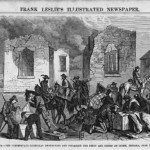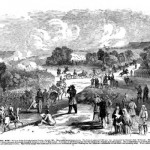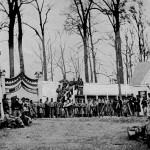In the midst of the American Civil War, what began as a small diversionary foray into the North by the Confederate Army during the Tullahomma Campaign, became a full-fledged Southern invasion that stretched across a thousand Union miles.
Beginning in Tennessee and traveling through Kentucky, Indiana, and Ohio, this famous incursion has become known simply as Morgan’s Raid.
On July 8, 1863, the sound of shells exploding filled the air, as Confederate General John Hunt Morgan’s troops crossed the Ohio River near the small town of Mauckport, Indiana.
Previously, Morgan had deployed a spy, Thomas Hines, to discover whether Hoosier feeling would be in any way sympathetic to the Confederates. He found little support for the Southerners, and was forced to flee back to Kentucky when it was discovered that he was an interloper.
Stealing two steamboats, the J.T McCombs and the Alice Dean, on the Kentucky bank, the cavalry evaded the inexperienced artillery fire of the Indiana home guard, sending them scrambling under a heavy barrage of artillery fire. In total, it took 17 hours for all of Morgan’s troops to successfully cross the river.
Undeterred by the skirmish and clear Confederate orders to remain behind, Morgan continued to push his forces northwest, reaching Corydon, Indiana’s former capital until 1825, the following day. A few miles outside the city, the general was accosted by 400 enthusiastic but inexperienced Union volunteers, who had been hastily organized by Governor Oliver Morton, a strong supporter of the Union cause.
The town’s valiant efforts to defend itself came to an abrupt end when Morgan’s troops fired two warning shots that resulted in 15 Corydon casualties. Immediately realizing the hopeless situation of protecting the town from 2,500 advancing cavalrymen, Union Colonel Lewis Jordan raised the white flag in surrender to avoid unnecessary loss of life.
The Confederate cavalry, encouraged by their victory and Morgan’s orders, rushed in to the town, raiding and ransoming what they could find. In addition to a few civilian deaths, the damaged or stolen goods totalled almost the equivalent of $500,000 in modern currency, most of which was reimbursed by the government.
Though the Battle of Corydon itself was a Confederate victory, Morgan’s Raid concluded with Morgan’s capture and eventual death. It was one of the few Civil War battles fought in the North, and remains the last battle to have been fought within Indiana borders.
Morgan’s Raid has been memorialized by the John Hunt Morgan Heritage Trail. Stretching through Kentucky and Indiana, it allows visitors to follow the historical path of Morgan’s Raid themselves. True adventurers sometimes choose to participate in the annual battle reenactment, a weekend affair complete with Ladies’ Tea and Military Ball.






















